|
   |
|
Page 5 |
Newsletter 136 Spring 2022 © Hampshire Mills Group |
|
Leitir Corn Mill, Donegal
Ruth Andrews
Photos by Keith and Ruth Andrews |
|
We thought we had failed to find any open mills to
visit in Ireland but as we were driving back to our
holiday cottage at Lettermacaward we came across a
prominent roadside notice declaring ‘MILL OPEN DAY
SATURDAY’.
Unfortunately it was only Friday but we could see a
couple of men raking a huge new car park. So as
always we stopped to inquire if we could have a
sneak preview. |
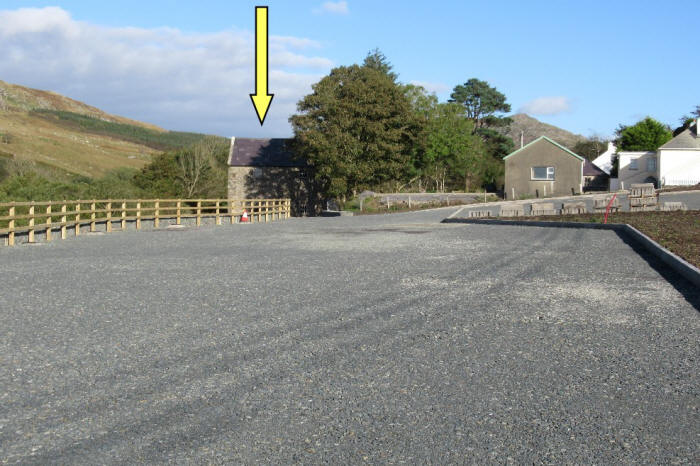
The mill building (arrowed) is to the left of
the tree. The view below shows the front of the
mill. |
|
We were enthusiastically welcomed inside and shown
around by the owner Michael Ward, who had donated
the mill and mill house on a long term lease to the
community, along with a field to develop into a
coach and car park. This car park, costing a
reportedly €250,000 is the latest stage in the
Leitir Corn Mill conservation project, which aims to
redevelop the site as a working heritage mill.
|
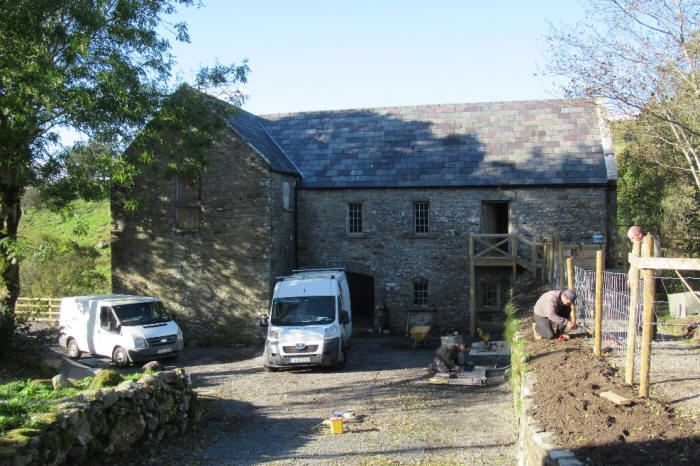 |
|
Launched in 2015, the project was divided into 5
phases, of which the car park is phase 3.
Rebuilding the wheel, repairing internal machinery,
and refurbishing the 19th century miller’s cottage
to include that all-important café and souvenir shop
will make up the final phases.
After several years of writing about mills Keith and
I now know that we can usually find historical
details on the internet, and Leiter Mill in south
east Donegal is very well documented: see
www.leitircornmill.com ; unlike Collooney
Mills! (see page 4).
The two-storey stone mill with blue Bangor-slate
roof dates back to the late 1700s and was
refurbished around time of the Great Famine
(1845-49), and again in 1862 when a new corn-drying
kiln and machinery from Stevenson’s foundry in
Strabane was installed. There is a good record of
millers right up to 1954 when Columbus Ward, father
of the present owner, took over. In his own words
“It was on its last legs” and apparently only 188
bags of oats were milled between March and May. The
mill then stood idle for 67 years, but although
silent, it was not abandoned, but was kept in good
repair.
The oats for milling were grown locally on small
farms and brought to the mill by horse and cart,
often with a supply of turf (peat) for the drying
kiln
[1]. |
 |
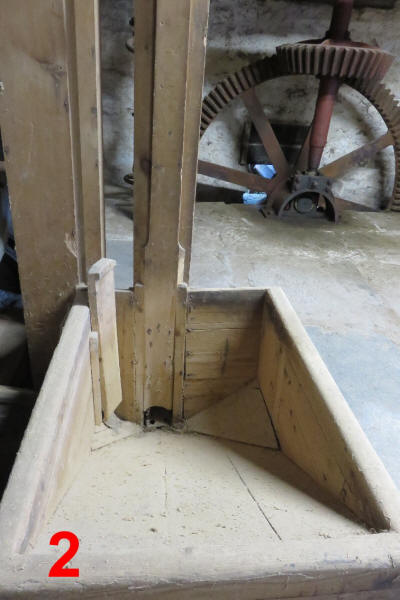 |
|
The dried oats were tipped into a small hopper [2]
before being transported up the corn elevator and
through a corn cleaning sieve, the dark wooden
object at the lower left of the picture [3].
|
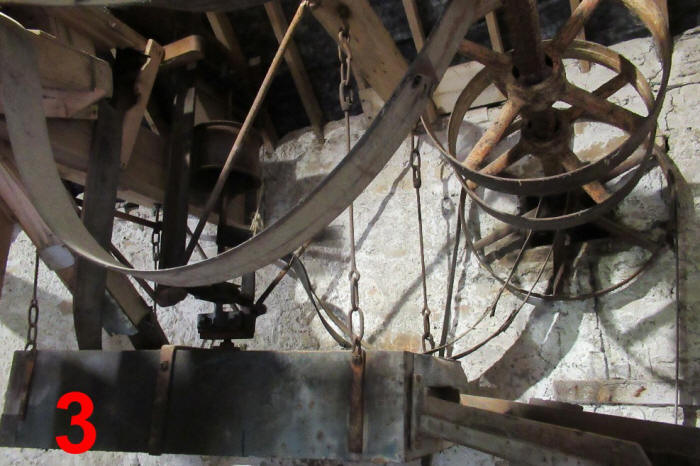 |
 |
From here it passed into the eye of the shilling
(shelling) stones. They are grey granite quarried
at Lettercran, Pettigo in County Donegal, 4ft 6in in
diameter
[4].
Here the husks were flaked off and the groats (hulled
kernels) transported up a groats elevator and
through a fanner/winnower
[5]
to remove the husks.
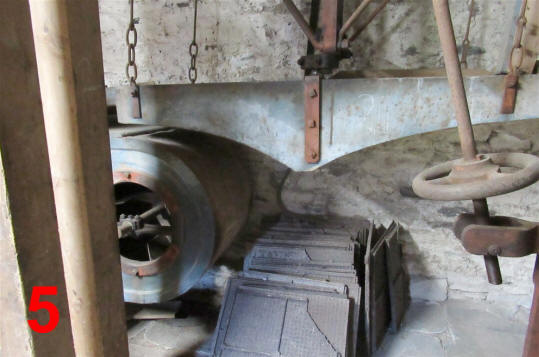
|
|
The groats were then transformed into meal in a
second pair of stones made of French burr
[6].
The cast iron plate on these meal stones reads
kay and hilton, fleet street, liverpool,
1863,
and they are also 4ft 6in in diameter.
Finally the meal was put through a meal sieve
[7]
before being sacked; note the pedestal chute under
the sieve.
All of the machinery is in its original position
complete with connecting belts and chains, apart
from the cast iron perforated plates of the kiln,
which are stacked below the fanner/winnower
[5].
We were pleased to see that the pit wheel, wallower,
and great spur wheel had not been enclosed (yet!) in
a visitor-proof corral
[8].
|
 |
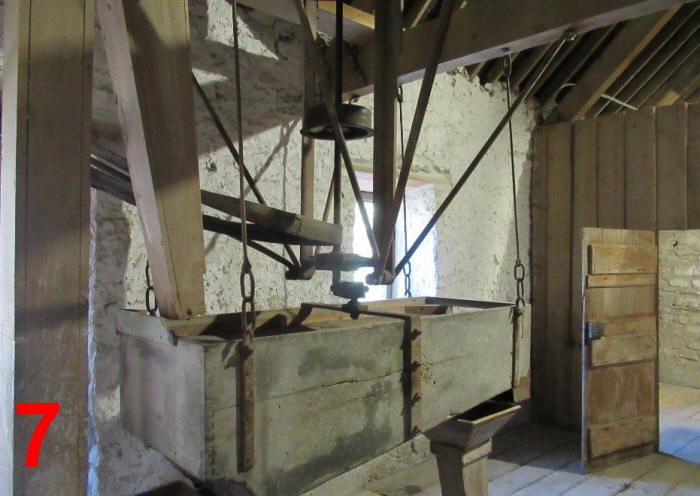 |

The metalwork was all cast in Strabane in 1862,
including the 17ft 6in diameter 5ft 2in wide high
breastshot waterwheel, which will soon have 48 new
buckets when the next stage of the restoration
happens. |
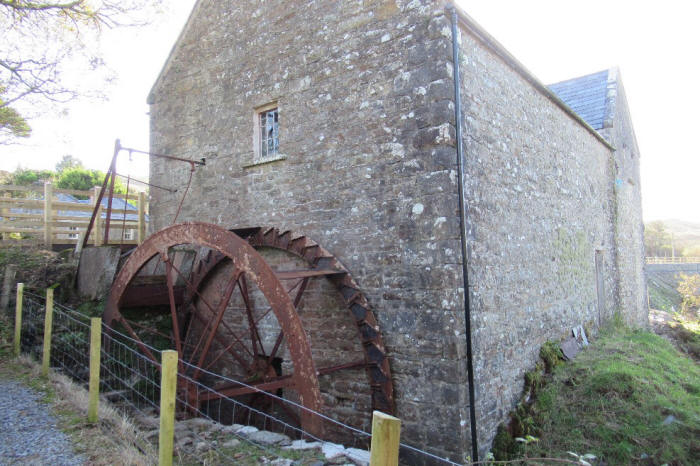 |
|
As the Donegal Diaspora website
www.donegaldiaspora.ie/project
says :
“Few of Ireland’s traditional corn mills have survived to the
present day with this level of preservation and
intactness. This site is an important part of the
19th century industrial heritage of not alone Kilcar,
but of the county and entire northwest region. The
grain milled was grown throughout this locality and
served to provide for some of the food needs of
Kilcar, Carrick, and Killybegs. It also catered for
the corn crops of small farmers in Glencolmcille,
Killybegs, and Teelin. Self-sufficient farmers
brought their cut corn to the mill. They also
supplied turf for the kilns used to dry the corn.
This is really an outstanding reminder of the
industrial/agricultural heritage of the area.”
|
|
   |
|
|
